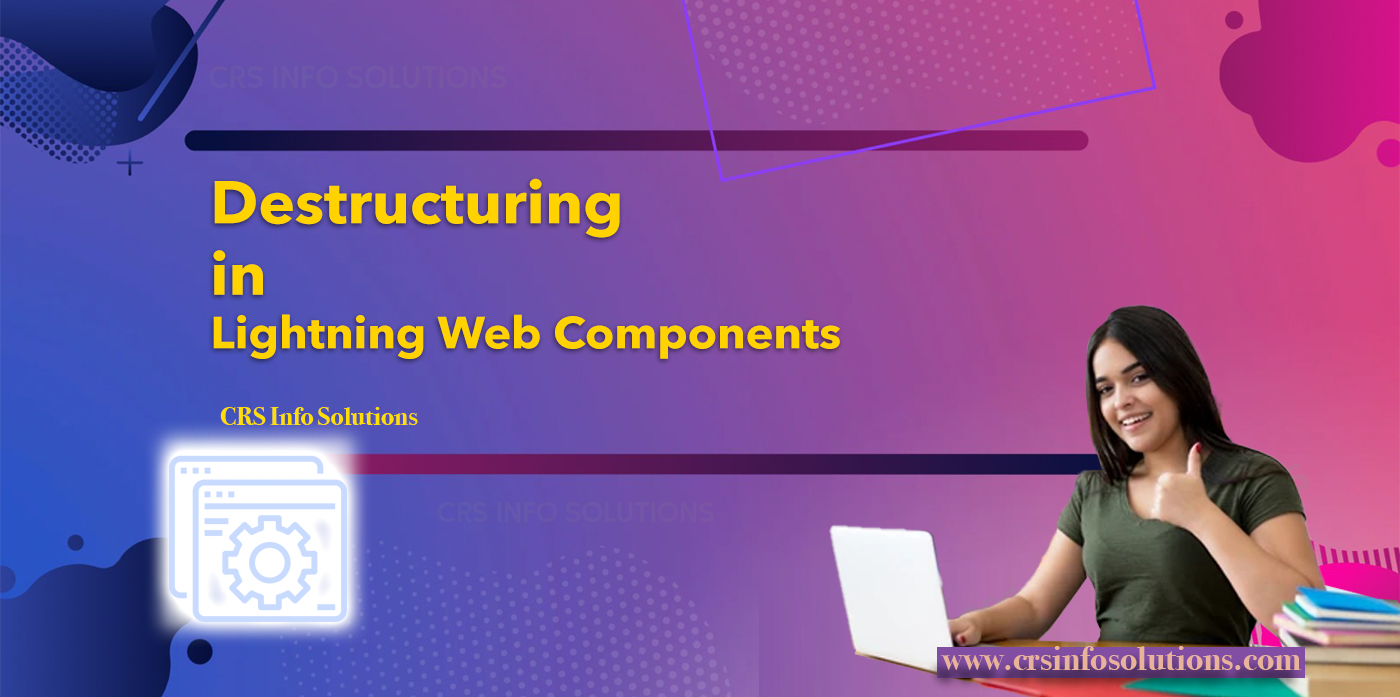
Destructuring in Lightning Web Components

Table of Contents:
- Understanding Destructuring
- Destructuring Arrays
- Destructuring Objects
- Destructuring in Function Parameters
- Best Practices
- Common Mistakes
- Interview Questions and Answers
- What is destructuring in JavaScript?
- How can destructuring be applied?
- Pitfalls of using destructuring in LWC
As a beginner in Lightning Web Components (LWC), one concept that significantly improved my coding efficiency is destructuring. Destructuring is a JavaScript feature that allows you to unpack values from arrays or properties from objects into distinct variables. It’s a powerful tool that can make your code cleaner and more readable. Let me walk you through the basics of destructuring and how it can be applied in LWC.
Understanding Destructuring
Destructuring simplifies the way you extract data from arrays or objects. Instead of accessing each element or property individually, you can unpack them in a single line of code. This not only makes your code more concise but also enhances its readability.
Example Code Snippets and Their Explanation
Destructuring Arrays:
Suppose you have an array of account names and you want to extract the first two names into separate variables.
const accountNames = ['Acme Corp', 'Global Inc', 'Tech Solutions'];
const [firstAccount, secondAccount] = accountNames;
console.log(firstAccount); // Output: 'Acme Corp'
console.log(secondAccount); // Output: 'Global Inc'
In this example, the first two elements of the accountNames array are unpacked into firstAccount and secondAccount variables using array destructuring.
CRS Info Solutions offers real-time Salesforce course for beginners designed to equip learners with practical knowledge and industry skills in Salesforce. Enroll for demo today.
Destructuring Objects:
When working with objects, destructuring can be even more beneficial. Let’s say you have an object representing a user’s profile and you want to extract specific properties.
const userProfile = { name: 'John Doe', age: 30, email: 'john.doe@example.com' };
const { name, email } = userProfile;
console.log(name); // Output: 'John Doe'
console.log(email); // Output: 'john.doe@example.com'
In this example, the name and email properties of the userProfile object are unpacked into corresponding variables using object destructuring.
Destructuring in Function Parameters:
Destructuring can also be used in function parameters to directly extract properties from an object argument.
function displayUserInfo({ name, age }) {
console.log(`Name: ${name}, Age: ${age}`);
}
const user = { name: 'Jane Doe', age: 28, email: 'jane.doe@example.com' };
displayUserInfo(user); // Output: 'Name: Jane Doe, Age: 28'
In this example, the displayUserInfo function uses destructuring in its parameters to extract the name and age properties from the user object passed as an argument.
Best Practices
Simplifying data access in Lightning Web Components (LWC) is essential for writing clean and maintainable code. One of the best practices to achieve this is through the use of object and array destructuring. Destructuring allows you to extract multiple properties from an object or items from an array with a single statement, making your code more concise and readable.
Consider the following example where we have a component that displays information about a car. Without destructuring, you would access each property individually:
import { LightningElement, api } from 'lwc';
export default class CarDetails extends LightningElement {
@api car;
get carDetails() {
return `Make: ${this.car.make}, Model: ${this.car.model}, Year: ${this.car.year}`;
}
}
In this code, this.car.make, this.car.model, and this.car.year are accessed individually. This approach can become cumbersome if you have to deal with multiple properties.
Now, let’s refactor the same code using object destructuring:
import { LightningElement, api } from 'lwc';
export default class CarDetails extends LightningElement {
@api car;
get carDetails() {
const { make, model, year } = this.car;
return `Make: ${make}, Model: ${model}, Year: ${year}`;
}
}
In this refactored code, we use object destructuring to extract the make, model, and year properties from this.car in a single line. This makes the code cleaner and easier to read. Destructuring is particularly useful when you need to access multiple properties or items, as it reduces the amount of code you need to write and makes your code more declarative.
In summary, destructuring in Lightning Web Components is a powerful feature that can simplify data access and improve the readability of your code. By extracting multiple properties or items with a single statement, you can write more concise and maintainable code.
Common Mistakes
When simplifying data access through destructuring in Lightning Web Components (LWC), developers can sometimes make common mistakes that lead to bugs or unexpected behavior. It’s important to be aware of these pitfalls to ensure that your code is robust and reliable.
One common mistake is not checking for null or undefined values before destructuring an object. This can lead to runtime errors if the object you’re trying to destructure is null or undefined.
For example:
import { LightningElement, api } from 'lwc';
export default class CarDetails extends LightningElement {
@api car;
get carDetails() {
const { make, model, year } = this.car; // Potential error if this.car is null or undefined
return `Make: ${make}, Model: ${model}, Year: ${year}`;
}
}
In this code, if this.car is null or undefined, attempting to destructure it will throw a TypeError. To avoid this, you can provide a default value for the object you’re destructuring:
import { LightningElement, api } from 'lwc';
export default class CarDetails extends LightningElement {
@api car;
get carDetails() {
const { make, model, year } = this.car || {}; // Provide an empty object as a default value
return `Make: ${make}, Model: ${model}, Year: ${year}`;
}
}
By providing an empty object as a default value, you ensure that destructuring does not throw an error if this.car is null or undefined.
Another common mistake is failing to handle the case where a destructured property is undefined. For example, if the car object does not have a year property, destructuring will assign undefined to the year variable:
const car = { make: 'Toyota', model: 'Corolla' };
const { make, model, year } = car;
console.log(year); // undefined
To handle this, you can provide default values for the destructured properties:
const car = { make: 'Toyota', model: 'Corolla' };
const { make, model, year = 'Unknown' } = car; // Provide a default value for 'year'
console.log(year); // 'Unknown'
In this revised code, if the year property is missing from the car object, the year variable will be assigned the default value 'Unknown'.
In summary, common mistakes when using destructuring in LWC include not checking for null or undefined values before destructuring and failing to handle undefined properties. By being aware of these pitfalls and using default values, you can write more robust and error-free code.
Interview Questions and Answers on Destructuring in LWC
1. What is destructuring in JavaScript, and how can it be used in Lightning Web Components (LWC) to simplify code?
Destructuring in JavaScript is a syntax feature that allows for the unpacking of values from arrays or properties from objects into distinct variables. In LWC, destructuring can be used to simplify the way you access and use data within your components.
// Object destructuring example
const user = { name: 'John Doe', age: 30 };
const { name, age } = user;
console.log(name); // Output: 'John Doe'
console.log(age); // Output: 30
// Array destructuring example
const scores = [98, 95, 93];
const [firstScore, secondScore] = scores;
console.log(firstScore); // Output: 98
console.log(secondScore); // Output: 95In these examples, object and array destructuring are used to extract specific pieces of data into variables, making the code more concise and readable.
2. How can destructuring be applied to function parameters in LWC, and what are the benefits of this approach?
Destructuring can be applied to function parameters in LWC to directly extract properties from an object argument or elements from an array argument. This approach can make function signatures more concise and improve the readability of the code.
function displayProduct({ id, name, price }) {
console.log(`Product ID: ${id}, Name: ${name}, Price: $${price}`);
}
const product = { id: 'p001', name: 'Laptop', price: 1200 };
displayProduct(product); // Output: 'Product ID: p001, Name: Laptop, Price: $1200'In this example, the displayProduct function uses destructuring in its parameters to extract the id, name, and price properties from the product object. This makes the function easier to understand and use.
3. What are some potential pitfalls of using destructuring in LWC, and how can they be avoided?
One potential pitfall of using destructuring in LWC is the risk of trying to destructure undefined or null values, which can lead to runtime errors.
const user = null;
const { name, age } = user; // TypeError: Cannot destructure property 'name' of 'user' as it is null.In this example, attempting to destructure the user object, which is null, results in a TypeError. To avoid this pitfall, ensure that the value being destructured is not null or undefined, or provide default values when destructuring.
const user = null;
const { name = 'Unknown', age = 0 } = user || {}; // Default values provided
console.log(name); // Output: 'Unknown'
console.log(age); // Output: 0In this revised example, default values are provided for name and age, and the logical OR operator (||) is used to ensure that an empty object is used for destructuring if user is null or undefined. This prevents runtime errors and ensures that the code is more robust.
CRS Info Solutions offers real-time Salesforce course for beginners designed to equip learners with practical knowledge and industry skills in Salesforce. Enroll for demo today.
If you’re preparing for a Salesforce developer role, it’s essential to brush up on your knowledge of Lightning Web Components (LWC). To help you ace your interview, we’ve compiled a comprehensive list of LWC interview questions and answers that cover the fundamentals, best practices, and advanced concepts of LWC development. Check out our guide to boost your confidence and increase your chances of success.

